‘Receivership’: a New Media Exhibition | University of California, Santa Cruz, USA
The exhibition 'Receivership', at the University of California Santa Cruz (UCSC), featured the works of thirteen MFA students in the Digital Art and New Media (DANM) program. It was a cumulative and meaningful moment for the exhibiting artists, who all spent more than a year creating the works, as well as thesis papers.
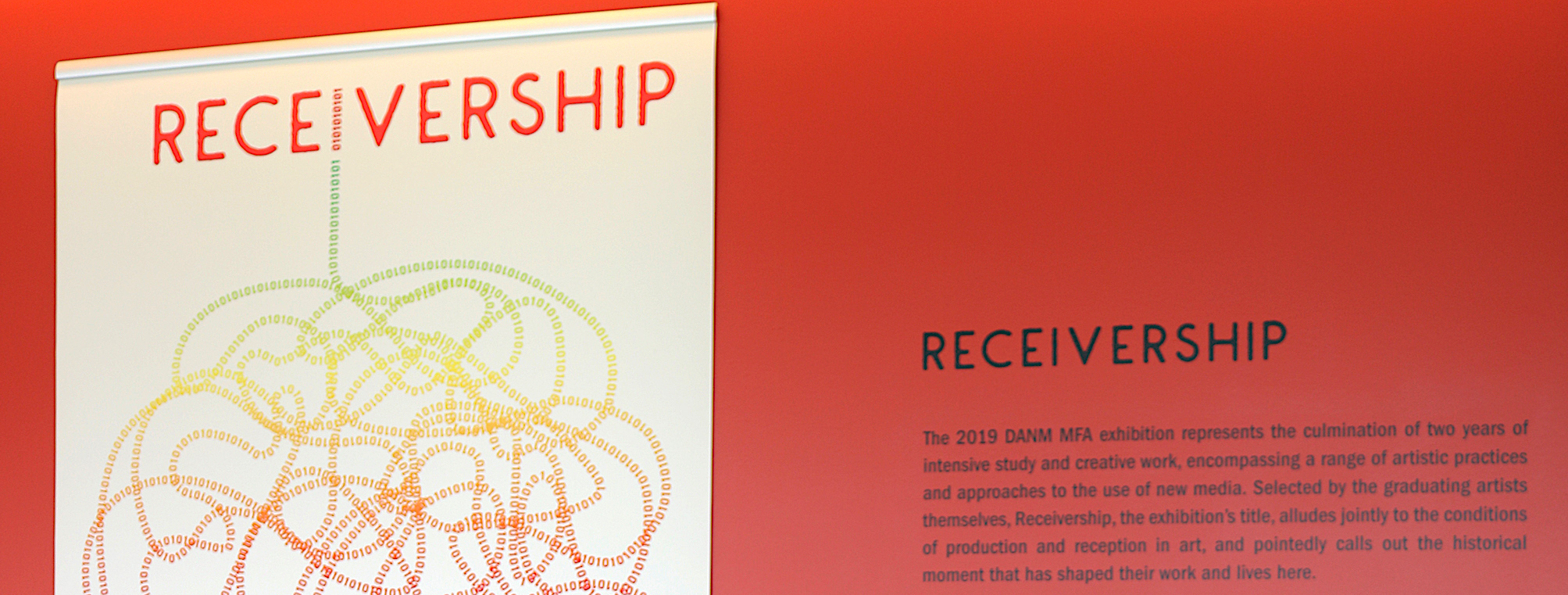
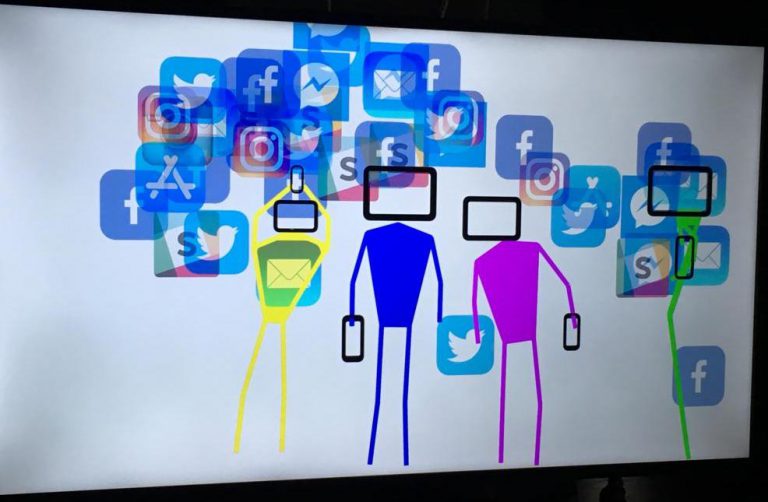
Exhibiting students:
Shimul Chowdhury, Kathleen Deck,
Kavi Duvvoori, Keegan Farrell,
Richard Grillotti, Chelsea Jones,
Yanzi Li, Jordan Magnuson,
Avital Meshi, Matthew Mitchell,
Zoe Sandoval, Laura Stevenson,
Gregory Sullo
The artists not only produced the works for the show, but also wrote thesis papers that were published in July 2019: https://guides.library.ucsc.edu/etds
Exhibition Theme & Context
The title of the exhibition, Receivership, was selected by the students because of its dual meaning in representing both the conditions of production and reception in art and the changes that occurred while attending the UCSC DANM program. In the Fall 2016 the University threatened to close down the Digital Art and New Media (DANM) program and put it into a state of “receivership , meaning under strict review and control by an outside administrator. The new administrative leadership stepped in and threatened the viability of the program. The exhibition cohort worked together during the academic year to ensure that DANM was reinstated as a strong, independent program once again.

The exhibition demonstrated both cohesion and perseverance and carried an inspiring spirit throughout. This show embraced the diversity of mediums used to depict a wide range of subject matter. It included everything from textile work, to sound sculptures, to a resonance chair that you could customize to your desired frequency. This was an effective convergence of the arts, digital technology, the humanities, and the sciences, displaying to the public and to the university the unique and powerful work being done in this program.
Artworks
The exhibition was spread across three locations on campus: the Digital Arts Research Center (DARC), the Mary Porter Sesnon Gallery, and the Porter Faculty Gallery. The thirteen artists were purposefully distributed throughout the galleries by the curator, John Weber, Director of the Institute of Arts and Sciences, locating spaces best suited to the artworks.
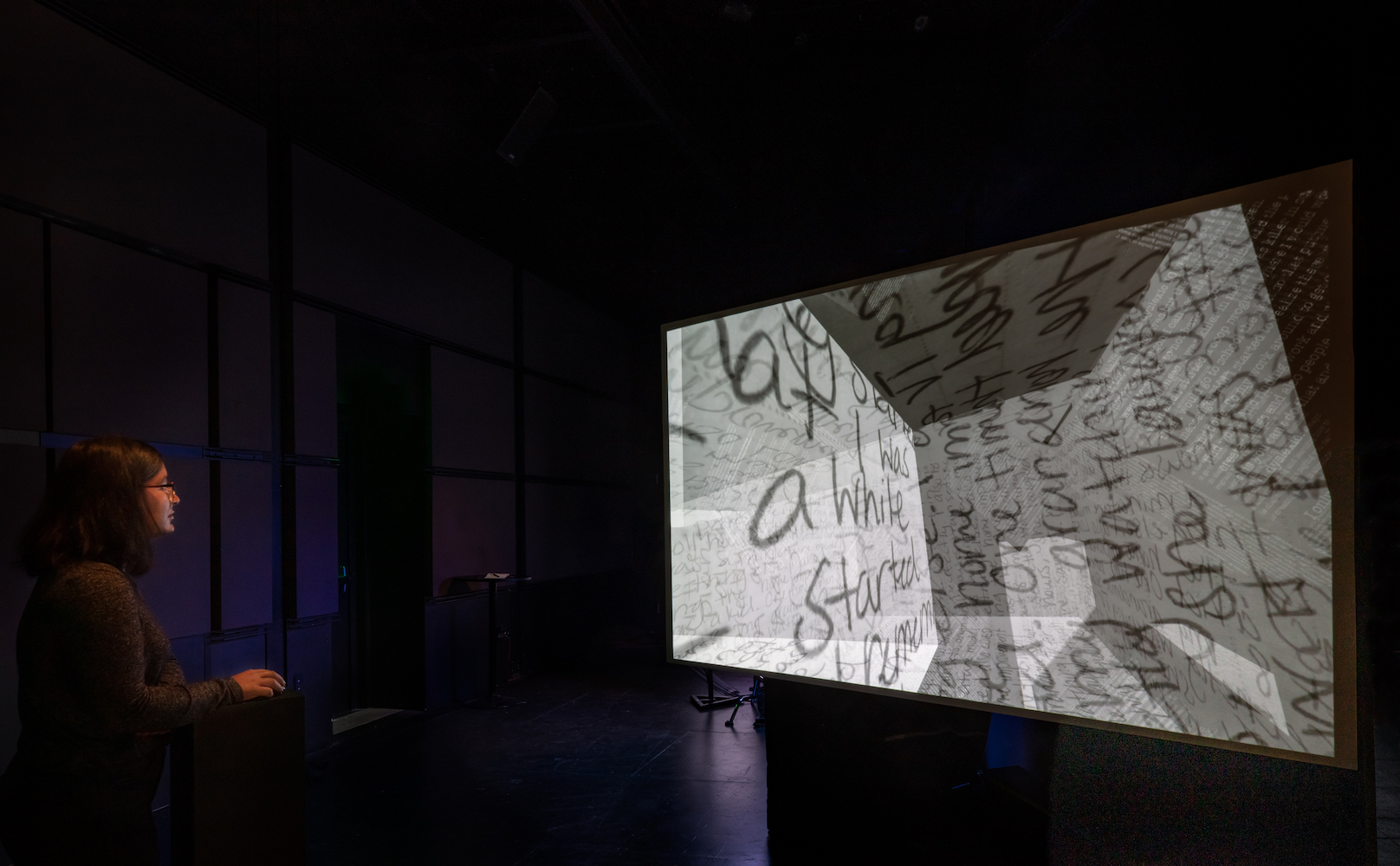
The first floor of the DARC included seven artists. This was the darkest and most interactive of the locations. As you walked into the space, you were invited to interact with several pieces, using your body and hands to engage with the work. The piece by Laura Stevens, Neither Contradictory nor Coincidental, challenged the stigma associated with dyslexia. By using a mouse on a pedestal in front of a large screen, interactive text and audio appeared that demonstrated both the talents that accompany dyslexia and the unfortunate consequences that may follow a dyslexic student’s limited access to appropriate information regarding their learning style.
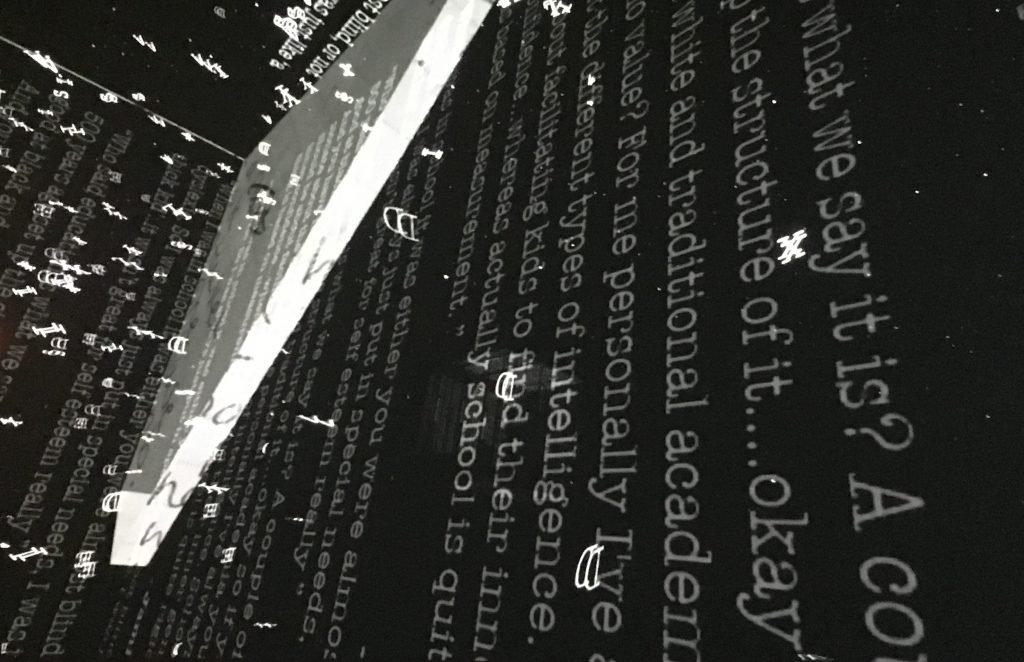
Rather than viewing this learning style as something to be corrected, the piece examined the strengths found in cognitive abnormalities. This piece placed the viewer in a disorienting world, forcing the viewer to interact and, possibly, understand a bit more about how dyslexia might feel.
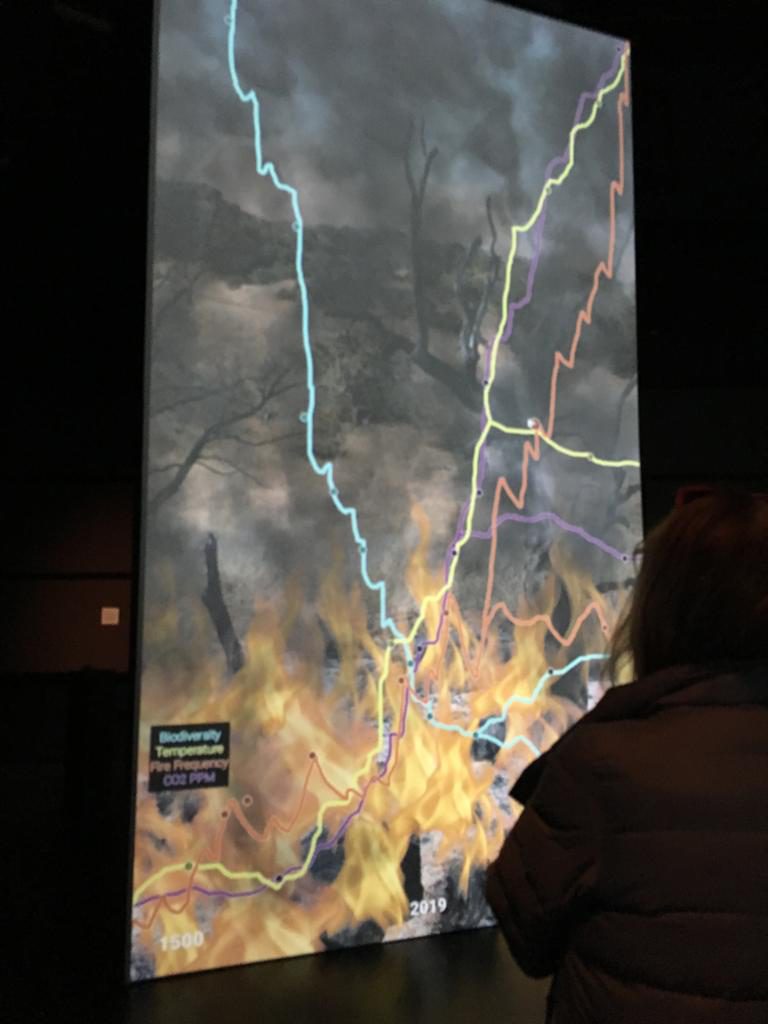
The DARC first floor included other fantastic works, including:
Code-Switching by Keegan Farrell,
Enviro-Envision by Kathleen Deck,
Wandering by Yanzi Li,
Video Games after Poetry by Jordan Magnuson,
Classification Cube by Avital Meshi,
and Resonant Waves by Richard Grillotti.
The second floor of the DARC featured computer generated sound art, by artist Matt Mitchell, After W.D. Stewart and Walter Jackson, a piece of music about the music of W.D. Stewart and Walter Jackson. This generative electronic music composition created beautiful howling sounds that could be heard from anywhere on the second floor.
The third and top floor of the DARC exhibited work by artist, Zoe Sandoval: { remnants } of a { ritual }.

It was an immersive, participatory installation that explored the crossroads of nostalgia, love, and longing. It offered an emergent, personal reflection on Venezuelan diaspora and memory crystallization. Audiences were encouraged to write love letters to the future and to other non-tangible things in a very tactile and intimate way. Once finished with your letter you added it to a bowl in the center of the room that collected the floating notes and caused their slow crystallization over time. This piece lets the viewer meditate on personal feelings and brings them together silently through this participatory work.

In the Mary Porter Sesnon Gallery were located three works: Stitching Solidarity by Shimul Chowdhury, “Untitled” by Kavi Duvvoori, and JOYGRIEF by Chelsea Jones. Jones’ JOYGRIEF was a multi-channel sound installation exploring the emotions of joy and grief and overall the human experience. This piece cycled through different voices and responses to both existential and lighthearted questions. As you stood in the middle of the circle of speakers you felt overwhelmed by the personal and heartfelt comments that you heard. The audience is invited to look inward and have a moment to reflect on the joy and grief present in their lives.
The Porter Faculty Gallery featured Greg Sullo’s piece, “Musicians,” and was what the artist refers to as a “sound sculpture.” Throughout the gallery were five sculptures strategically placed that emitted sign waves at different frequencies. As you walked through the room you could create a personal composition by moving through and under the sculptures. This piece paid careful attention to not privilege one perspective or experience. This made for a unique and individual interaction with the piece.
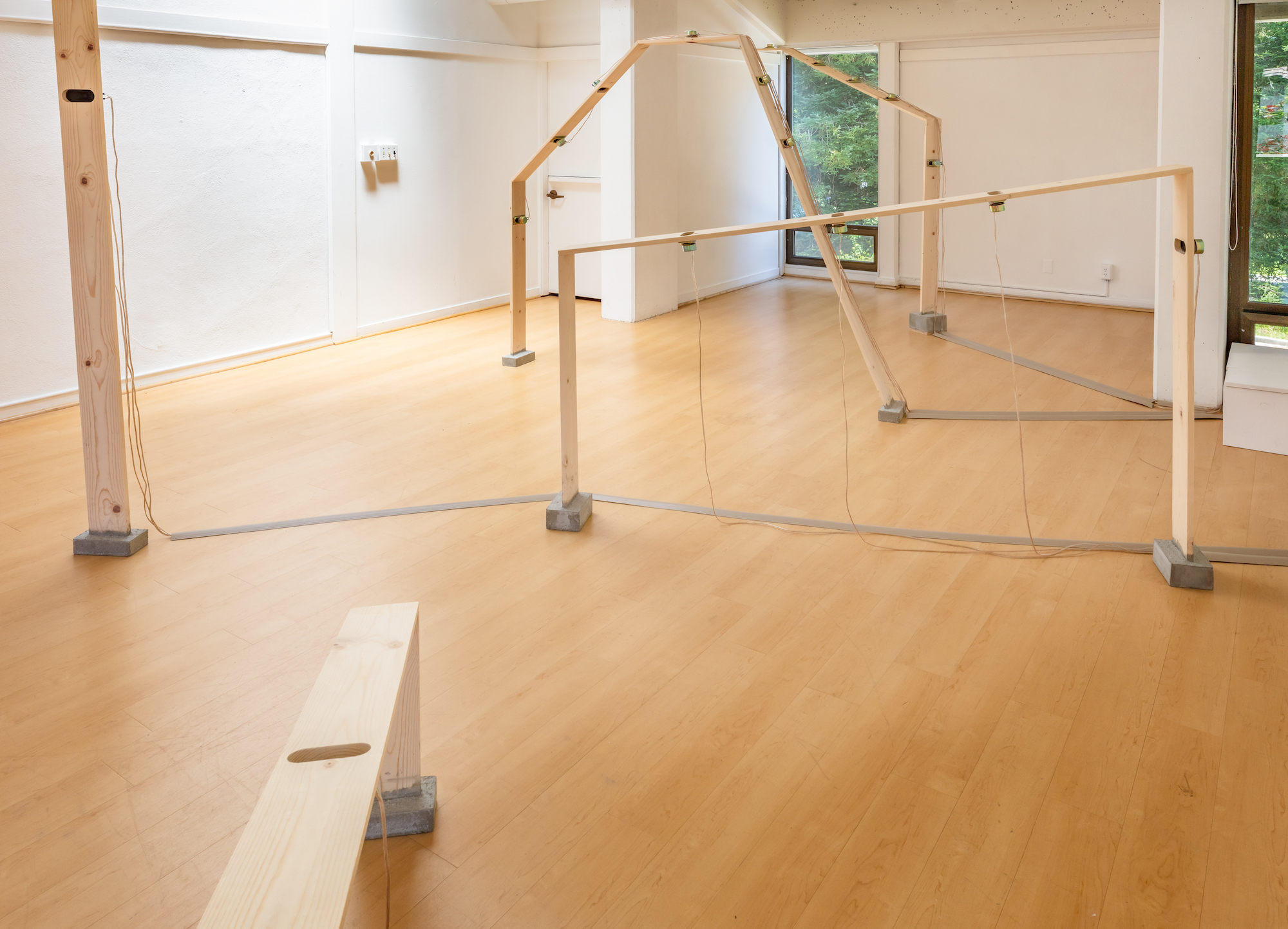
Impact
The Receivership exhibition was an excellent show applauded by the university and community. Many people told me that they thought a show like this should happen all of the time. This exhibition was an opportunity to showcase and highlight the creative work being done at the cross section of disciplines at UCSC. The Digital Art and New Media program has a reputation at the college for having dedicated students who are willing to push boundaries in order to re-define and invent new categories of exploration. When this can happen, innovation and discovery occurs. This convergence of subject matters helps the audience and the artists examine culture, society, and the digital world. It is opportunities like the Receivership show that get us to rethink our educational experience and everyday lives.
---------------------------------------------------------------------------------------------------------------
Author Kathleen Deck is an emerging artist contemplating science,
art, the environment, and climate change in her work. Through her
artistic research practice, she seeks to create work that challenges
viewers to become actively engaged and educated in environmental
issues with the hope that an informed public can help forge a more
sustainable society.